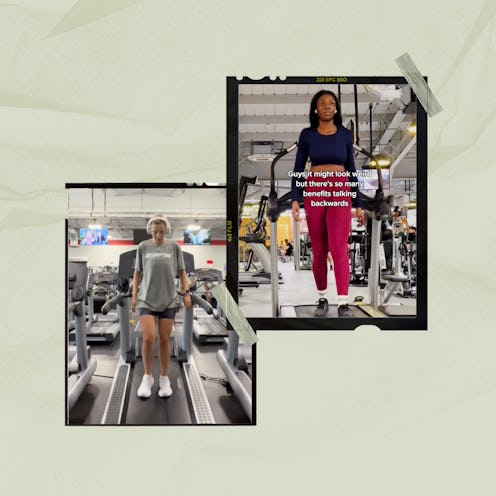
Thanks to a new TikTok trend, it’s only a matter of time before you spot someone casually walking backwards in the park, on a treadmill, or while running errands around town. (OK, maybe not that last one.)
With over 36 million views, the people of FitTok have been raving about the benefits of trekking around in reverse. While it does sound completely random, experts agree that a backwards walk comes with some major health benefits, like building new muscles and improving balance.
You don’t have to stroll the wrong way for long — walking backwards in short bursts is a worthwhile way to boost your overall well-being, says Michael Hamlin, NSCA, CSCS, a personal trainer and founder of Everflex Fitness. Here’s what happens to your body when you flip it and reverse it.
Legit Reasons To Walk Backwards
When you’re walking backwards instead of forwards, you’re working your muscles in a different way than you do when taking a forward stroll, says Hamlin. Specifically, you’re putting an extra focus on your quads.
Sure, there are plenty of other ways to strengthen these muscle groups — like good, old-fashioned squats — walking backwards is an interesting way to spice up your leg day. And its benefits go beyond boosting your lower body strength.
“Additionally, walking backward may improve balance and proprioception as it challenges the body to move in an atypical way, enhancing spatial awareness and coordination,” Hamlin says.
Another perk? It can do wonders for nagging knee pain. That’s because it balances the muscles in your legs so that they offer more support.
As a bonus, it might also be good for your noggin. “Walking backward can provide cognitive benefits,” says Hamlin. “It requires increased focus and concentration, potentially stimulating the brain.”
How To Give It A Try
The easiest way to walk backwards is by facing the wrong way on a treadmill as you walk at a slow pace in reverse.
“Begin with short distances and gradually increase the incline, if you like, as you become more comfortable,” says Hamlin. As you stroll, focus on standing up straight, keeping your core engaged, and maintaining balance.
Aim for five minutes to start, either as a warm-up before your usual workout or as part of a cooldown. Then, try working your way up to 10 minutes.
While people might look at you sideways in the gym, it’ll be worth it for all those benefits.
Studies referenced:
Cha, HG. (2016). Therapeutic efficacy of walking backward and forward on a slope in normal adults. J Phys Ther Sci. doi: 10.1589/jpts.28.1901. Epub 2016 Jun 28. PMID: 27390443; PMCID: PMC4932084.
Wang, J. (2019). Effectiveness of backward walking training on balance performance: A systematic review and meta-analysis. Gait Posture. doi: 10.1016/j.gaitpost.2019.01.002.
Source:
Michael Hamlin, NSCA, CSCS, personal trainer, founder of Everflex Fitness